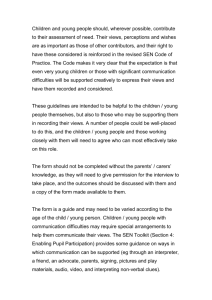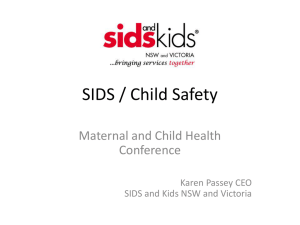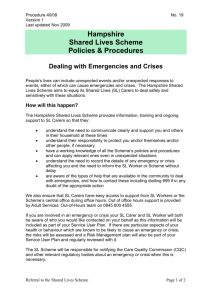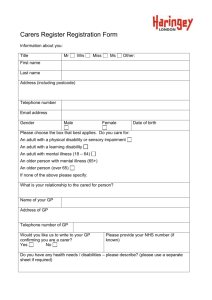Sample Rest and Sleep Policy Template
advertisement
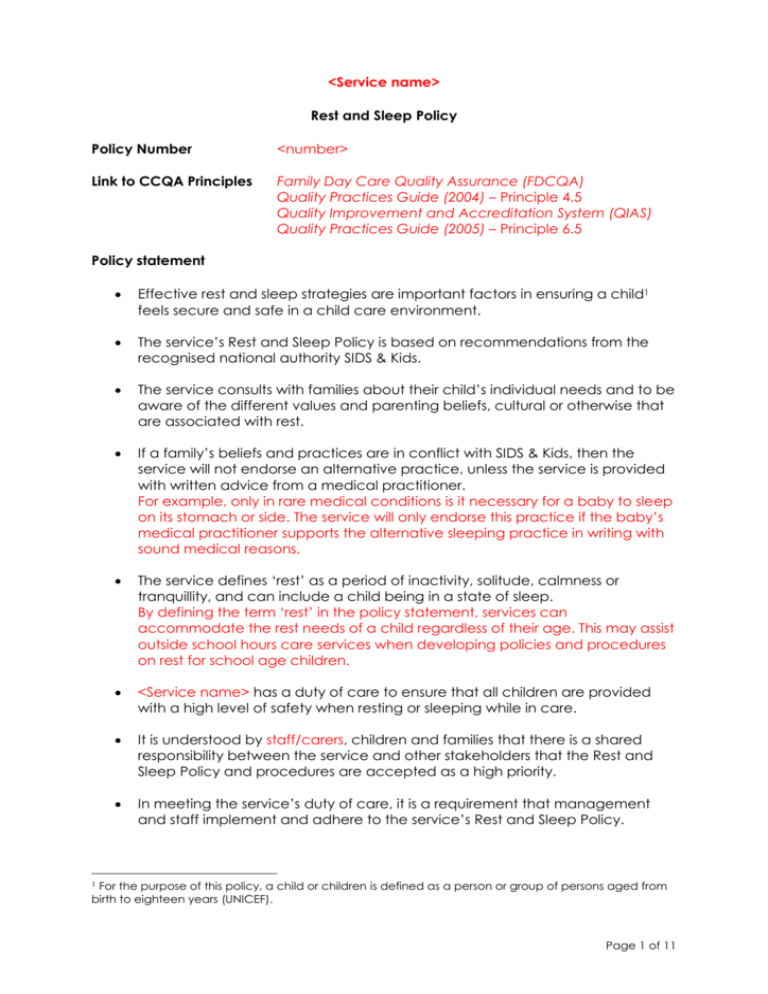
<Service name> Rest and Sleep Policy Policy Number <number> Link to CCQA Principles Family Day Care Quality Assurance (FDCQA) Quality Practices Guide (2004) – Principle 4.5 Quality Improvement and Accreditation System (QIAS) Quality Practices Guide (2005) – Principle 6.5 Policy statement Effective rest and sleep strategies are important factors in ensuring a child1 feels secure and safe in a child care environment. The service’s Rest and Sleep Policy is based on recommendations from the recognised national authority SIDS & Kids. The service consults with families about their child’s individual needs and to be aware of the different values and parenting beliefs, cultural or otherwise that are associated with rest. If a family’s beliefs and practices are in conflict with SIDS & Kids, then the service will not endorse an alternative practice, unless the service is provided with written advice from a medical practitioner. For example, only in rare medical conditions is it necessary for a baby to sleep on its stomach or side. The service will only endorse this practice if the baby’s medical practitioner supports the alternative sleeping practice in writing with sound medical reasons. The service defines ‘rest’ as a period of inactivity, solitude, calmness or tranquillity, and can include a child being in a state of sleep. By defining the term ‘rest’ in the policy statement, services can accommodate the rest needs of a child regardless of their age. This may assist outside school hours care services when developing policies and procedures on rest for school age children. <Service name> has a duty of care to ensure that all children are provided with a high level of safety when resting or sleeping while in care. It is understood by staff/carers, children and families that there is a shared responsibility between the service and other stakeholders that the Rest and Sleep Policy and procedures are accepted as a high priority. In meeting the service’s duty of care, it is a requirement that management and staff implement and adhere to the service’s Rest and Sleep Policy. For the purpose of this policy, a child or children is defined as a person or group of persons aged from birth to eighteen years (UNICEF). 1 Page 1 of 11 Rationale The rationale represents a statement of reasons that detail why the policy and/or procedures have been developed and are important to the service. SIDS & Kids is considered the recognised national authority on safe sleeping practices for infants and children. The SIDS & Kids Safe Sleeping Practices are based on scientific research. Sudden Infant Death Syndrome (SIDS) is the leading cause of post neonatal infant death from one to twelve months of age in Australia. (ABS, 2003) The SIDS & Kids evidence-based health promotion program Safe Sleeping Education has saved over 4,000 Australian babies, which equates to a 90% decline in SIDS cases since the risk reduction campaigns began in 1989. (ABS, 2003; SIDS & Kids, 2005a) Encouraging babies to play on their tummy assists in the development of gross motor strength, especially for crawling. It also helps in the prevention of flat spots forming on the head. However, babies should be supervised at all times during tummy play. (SIDS & Kids, 2006a) A safe sleeping practice, which includes placing a baby on their back to rest, does not affect a child’s physical development and does not delay the age they begin walking. (SIDS & Kids, 2006b) Please refer to: SIDS & Kids. (2005b). SIDS & Kids: Safe sleeping in child care kit. NSW: Author. SIDS & Kids website: http://www.sidsandkids.org/ Strategies and practices These are examples. Services are encouraged to develop and adapt the following strategies and practices as required to meet their individual circumstances and daily best practices. The primary safe resting and sleeping practices for children in care at this service are: All children will be placed on their back to rest when first being settled for a rest. If a child turns onto their side or stomach during sleep, then allow them to find their own sleeping position. All children will rest with their face uncovered. Children’s rest environments are free from cigarette or tobacco smoke as detailed in the service’s Smoke Free Environment Policy. The rest environment, equipment and materials will be safe and free from hazards as detailed in the service’s Occupational Health and Safety Policy and the Maintenance of Building and Equipment Policy. Staff/carers monitor resting children at regular intervals and supervise the rest environment as per licensing regulations/best practice standards. Safe resting practices for babies2 Babies will be placed on their back to rest. If a medical condition exists that prevents a child from being placed on their back, the alternative resting practice must be directed in writing by the child’s medical practitioner. If older babies turn over during their sleep, allow them to find their own sleeping position, but always lay them on their back when first placing them to rest. At no time will a baby’s face be covered with bed linen. 2 For the purpose of this policy, a baby is defined as a child aged from birth to 24 months. Page 2 of 11 To prevent a baby from wriggling down under bed linen, they will be placed with their feet closest to the bottom end of the cot. Quilts and duvets will not be used as bed linen. Pillows, soft toys, lamb’s wool and cot bumpers are not recommended. Light bedding is the preferred option, which must be tucked in to prevent the baby from pulling bed linen over their head. Sleeping bags with a fitted neck and arm holes are an alternative option to bed linen and encourage a baby to rest on their back. Sleeping bags should not have a hood. Safe resting practices for toddlers3 Toddlers will be placed on their back to rest, unless otherwise directed in writing by the child’s medical practitioner. If toddlers turn over during their sleep, allow them to find their own sleeping position, but always lay them on their back when first placing them to rest. At no time will a toddler’s face be covered with bed linen. If using a cot, toddlers will be placed with their feet closest to the bottom end of the cot to prevent them from wriggling down under bed linen. Quilts and duvets will not be used to cover toddlers in a cot or on a mattress. Pillows, soft toys, lambs wool and cot bumpers are not recommended. Light bedding is the preferred option, which must be tucked in to prevent the toddler from pulling bed linen over their face. Sleeping bags with a fitted neck and arm holes are an alternative option to bed linen and encourage a toddler to rest on their back. If parents request to continue using the sleeping bag option when the toddler rests on a mattress, then the service will comply. Quiet experiences may be offered to those toddlers who do not fall asleep. Safe resting practices for preschool children4 Preschool children will be placed on their back to rest. If they turn over during their sleep, allow them to find their own sleeping position but always ask them to lay on their back when first placing them to rest. At no time will a preschooler’s face be covered with bed linen when they are sleeping. Light bedding is the preferred option. Quiet experiences may be offered to preschoolers who do not fall asleep. Safe resting practices for school age children5 If a school age child requests a rest then there is a designated area for the child to be inactive and calm, away from the main group of children. The designated rest area may be a cushion, mat or seat in a quiet section of the care environment. Quiet, solitary play experiences are available for those school age children who request the need for a rest or time away from their peers. Safe resting practices are relevant to school age children because, if they are resting or sleeping they should be monitored at regular intervals and a school aged child’s face should be uncovered when they are sleeping. Light bedding is the preferred option. For the purpose of this policy, a toddler is defined as a child aged from eighteen months to three years. 4 A preschool child can be aged from three years to the child’s formal year of pre-primary school. 5 A school age child attends primary or secondary school. 3 Page 3 of 11 Safe resting practices for a child who is unwell Refer to the service’s Illness, First Aid and Supervision policies for additional information. A child will be placed on their back to rest when displaying signs of being unwell. If a child turns onto their side or stomach during sleep, then allow them to find their own sleeping position.6 All children will rest with their face uncovered. Children who are unwell will be given the highest supervision priority and monitored constantly especially if the child has: a high temperature, vomited or received minor trauma to their head. For example, a baby who is crawling topples over and bumps their head or a ten year old who receives a blow to the head while playing sport. Protective behaviours and practices Supervision of resting children All children who are resting will be supervised by staff/carers. Students or volunteers will not be left unsupervised when settling children for a rest. All children who have fallen asleep in the service will be monitored regularly with specific attention to breathing patterns. Adults will not rest or sleep in same environment as a child or group of children. Supervision ratios during resting periods in the day/night may be addressed by a licensing or regulatory agency. Services may decide to identify the staffing ratios during resting periods and the frequency that children are checked when resting in line with their licensing regulations. Supervision and its frequency are important factors in family day care or long day care services where cot rooms may be separate from the main play area. An example of how services may decide to address the issue of supervision and resting children could be: The service regularly checks the rest environment for children aged from 0-2, 2-3, 3-5 years every 10-15 minutes. Staff/carers observe the following: o the position of each child’s body in their cot/on their mattress; o each child’s breathing rate. If a child is not breathing then the staff/carer will commence the service’s first aid plan for a non-breathing child; o the arrangement of bed linen. If a child’s face is covered, the staff/carer will immediately uncover the child’s face; and o the environment. Staff/carers will monitor the temperature, the security of each cot (for example, are the sides of the cot up and/or locked) and environment safety (for example, location of heaters or hanging cords near cots). Please consider the age of the child, the nature of the illness or injury and the availability staff/carers. Unwell children should be constantly supervised. All babies should be placed on their back to sleep if they are unwell. The service should describe how it provides the safest strategies for children who are resting and unwell. 6 Page 4 of 11 First aid plan for a non-breathing child The service may detail the first aid procedures for a non-breathing child in this section of the policy or inform the reader to access the service’s First Aid Policy or Emergency Policy. First aid procedures must be sourced from a recognised authority. Settling children for rest The techniques and strategies for settling children before and during a rest period are varied and may be influenced by the service’s philosophy, the professional values of staff/carers and current best practice. The techniques and strategies for settling a child/children for rest may reflect the: o individual needs of the child or group of children; o parenting beliefs and values of families accessing the service; o professional philosophy, knowledge and experience of staff/carers; o cultural and religious practices; o frequency of days that the child attends care; o circumstances or events happening at home; o consistency of practices between home and care; o child’s general health and wellbeing; o status or condition of the rest environment; and o use of comforters or resting aids (including dummies and security blankets). There is no definitive recognised authority for settling practices for resting children. However, there are general best practice standards. When considering settling procedures for resting children, it is important for staff/carers to: o meet the individual needs of children; o maintain health and safety practices; o minimise any distress or discomfort; o acknowledge children’s emotions, feelings and fears; o avoid using settling and resting practices as a behaviour guidance strategy because the child begins to relate the rest environment, which should be calm and secure, as a disciplinary setting; and o understand that young children (especially from 0 to 3 years of age) settle confidently when they have formed bonds with familiar and trusted staff/carers. Services should prioritise their staffing needs with individuals who are familiar with the young children in care before using relief staff whom children may not know. Overnight care7 Overnight care is primarily a family day care practice. The issue of overnight care is a sensitive one because it involves the trust between a child, family, carer, the carer’s family and the coordination unit staff. Pivotal to this trust is the rights of a child to be cared for in a physically, emotionally and socially safe environment. Overnight care policies are not considered the same as ‘day-time’ policies; the provision of overnight care can have implications that are minimal or nonexistent in regular family day operations. For example, carers do not rest in the day-time when children are sleeping and are therefore, alert to children’s 7 For the purpose of this policy and procedure, the term ‘overnight care’ includes weekend care. Page 5 of 11 needs. However, a carer would also be asleep during a child’s overnight care experience, which poses different implications to the provision of care. It is important that all the stakeholders are involved in the development of overnight care procedures and guidelines; and that each stakeholder is aware of their obligations, legal or otherwise. The service can develop: o an overarching policy that covers all aspects of overnight care; o a group of policies about aspects of overnight care; and o procedures for overnight care are defined in existing policies for regular care. Services should reflect upon the following questions when developing an overnight care policy: o Is the child’s sleeping environment physically safe? For example, is the child sleeping in an older child’s room where there may be items that pose a danger? o Can the child access other parts of the house during the night without the carer’s knowledge? o Are other people able to access the child’s sleep environment without the carer’s knowledge? Services may decide to link this with their Child Protection Policy. o Has the carer and their family discussed and practiced a night-time emergency evacuation plan? For example, fire or intruder. o How will the carer ensure that the child is not exposed to experiences that may be inappropriate? For example, attending a neighbour’s barbeque where there may be alcohol or cigarette smoking; at a sporting arena where there may be offensive language; watching a movie or television program not recommended for children. In the best interest of the child, the child’s family, the carer, the carer’s family and the coordination unit staff, NCAC suggests that if services are providing overnight or weekend care that they develop sound procedures that promote the safety and wellbeing of children in care. Staff/carers, students and volunteers as role models Brief and concise detail of the service’s strategy. Children learn through example and role modelling is an important strategy in child care to maintain quality standards. Staff/carers, students and volunteers must comply with the Rest and Sleep Policy. The rest environment and equipment Provision and maintenance of rest and sleep equipment and environment Every <timeframe> the service will conduct a safety check of the resting environments, equipment and/or aids. If staff/carers identify any hazards they will lodge a report as instructed in the Maintenance of Building and Equipment Policy. Hanging cords or strings from blinds, curtains, mobiles or electrical appliances must be tied away from cots or mattresses to prevent a child from choking or hanging. The service does not permit the use of hot water bottles, electric blankets or heated wheat bags in children’s cots or on mattresses. These items present a risk of children either being scalded or developing hyperthermia (overheating). Page 6 of 11 If children are allowed to rest outdoors, the service may decide to identify how they will maintain a safe environment for children when resting. For example, when on an excursion staff may need to consider the resting facilitates at a park or at the local swimming pool. Cots The following information is directly referenced to: SIDS & Kids. (2005c) All new and second hand cots sold in Australia must meet the Australian Standards for Cots and be labelled AS 2172. Cots that are not labelled with the Australian Standards will not be used by the service. Staff/carers will ensure that all cots are placed in area that is a safe distance from heaters, electrical appliances and hanging cords or string. Staff/carers will not place an extra mattress or padding under or over the manufacturer’s cot mattress. Staff/carers will look for the following hazard signs: o loose or broken parts; o missing or loose knobs, screws or sharp catches; o peeling, cracking paint or splintered wood; and o any design flaw that reduces the safety of the cot. For example, missing or broken safety latches to sides. Staff/carers will report any hazards as detailed in the service’s Maintenance of Building and Equipment Policy. Note: Staff/carers should assess whether older babies or toddlers have the ability to climb over the sides of a cot as this presents a safety risk. Portable cots (or portacots) Portable cots should meet the Australian Standard (AS 2195). Staff/carers will ensure that a portacot is placed in an area that is a safe distance from heaters, electrical appliances and hanging cords or string. Only the supplied portacot mattress will be used in a portacot. Staff/carers will not place an extra mattress or padding under or over the manufacturer’s portacot mattress. Staff/carers will report any hazards as detailed in the service’s Maintenance of Building and Equipment Policy. Note: Staff/carers should assess whether older babies or toddlers have the ability to climb over the sides of a cot as this presents a safety risk. Mattresses Cot mattresses should be in good condition, clean, firm, flat and must fit the cot base with no more than a 25mm gap between the mattress and the sides of the cot. Soft mattresses increase the risk of SIDS as it encourages a baby to roll onto their stomach. A poor fitting mattress increases the size of the gap between the mattress and the sides of the cot. If lodged in the gap, a baby is unable to move their neck and head, which may cause them to stop breathing. Staff/carers will report any hazards as detailed in the service’s Maintenance of Building and Equipment Policy. Note: For information regarding second hand mattresses refer to: SIDS & Kids. (2005d). Information statement: Second hand mattresses. Page 7 of 11 Prams and strollers Children will be restrained at all times when in a pram or stroller, this includes resting or sleeping. Loose restraints are a safety risk and may lead to choking or hanging. If the service provides prams or strollers then they must meet the Australian Standards 2088. Children are not left unattended in prams or strollers. Staff/carers will restrain children correctly as directed by the manufacturer. A five-point restraint (defined as: straps over each shoulder, a waist belt and a crotch strap between the legs that all meet and are secured) is recommended and should replace existing restraints. (ACCC, 2006) Staff/carers will not overload the handles of prams or strollers with bags (or other materials) as this may force the pram or stroller to flip backwards due to the difference in weight distribution. Staff/carers will report any hazards as detailed in the service’s Maintenance of Building and Equipment Policy. Prams or strollers should not be used to restrain children as part of the service’s behaviour guidance procedures. Note: Staff/carers should assess whether older babies or toddlers have the ability to climb out of a pram or stroller as this presents a safety risk. Hygiene practices Every <timeframe> the babies’ cots are cleaned with <identify materials used and method of cleaning>. Every <timeframe> the children’s resting mattresses are cleaned with <identify materials used and method of cleaning>. Each child has their own bed linen. Children’s bed linen will be washed <timeframe>. Bed linen is supplied and washed <timeframe> by the child’s family. Other resting materials or aids, such as cushions, will be cleaned every <timeframe> with <identify materials used and method of cleaning>. Rest environment aesthetics The service can indicate how it maintains the room temperature, airflow and lighting during rest periods. This can include how music or language can assist children to rest in a calm and relaxing environment. Rest and sleep times of the day The service can detail the resting times of the day for children. For example, the service may encourage flexible resting period for babies while toddlers and preschool children may have a scheduled time of the day when rest time occurs (for example, after lunch). The service can identify how it meets the individual resting needs of children. For example, when a child is unwell, taking medication that causes drowsiness, after immunisation, stress, a change to sleeping patterns The service can identify the type of quiet experiences and physical spaces available to children throughout the care period. Sleepwear The following is a list of suggestions: Staff/carers monitor the temperature of the rest environment and address children’s clothing needs. Children’s sleepwear meets Australian Standards. Page 8 of 11 Children resting in jumpers with hoods and cords are at higher risk of choking and should not be encouraged to wear these garments when resting. Sleepwear should take into consideration the: o child’s age; o safe resting practices established by the service; o temperature of the rest environment; o bed linen used for resting; and o child’s individual needs. Communicating with different stakeholders Children Brief and concise detail of the service’s strategy. Families Brief and concise detail of the service’s strategy Rest strategies and practices are outlined in the Family Handbook, enrolment forms, newsletters and excursion permission forms. Information regarding SIDS & Kids Safe Sleeping Practices will be displayed on noticeboards. The service may identify if families will be encouraged to implement the service’s rest and sleep practices when engaged in service experiences. The service can consider the following reflective questions: o How do staff/carers communicate children’s sleep and rest times to families? o How do staff/carers communicate children’s sleep and rest times to each other during shift changes throughout the day? Staff/Carers Brief and concise detail of the service’s strategy. Staff/carers receive regular first aid training in resuscitation as defined by licensing regulations/best practice standards. Management/Coordination unit staff Brief and concise detail of the service’s strategy. Management/coordination unit staff receive regular first aid training in resuscitation as defined by licensing regulations/best practice standards. Experiences Brief and concise detail of the service’s strategy. Excursions Brief and concise detail of the service’s strategy. For example, staff/carers can identify how the rest requirements of children are met during: o An outside school hours excursion to the zoo or the park. The service may need to consider the provision of shade, if the surfaces are comfortable (grass, sand, cement) and schedule of excursion events and timeframes. o A play session at a carer’s home. The carer may need to consider what alternative resting arrangements or equipment may be needed if a child requires a rest during a play session in another carer’s home. Page 9 of 11 Policy review The service will review the Rest and Sleep Policy and procedures, and related documents, including behaviours and practices every <timeframe>. Families are encouraged to collaborate with the service to review the policy and procedures. Staff/carers are essential stakeholders in the policy review process and will be encouraged to be actively involved. Procedures The following are examples of procedures that a service may employ as part of its daily practices. Examples: Employee induction procedure. First aid procedures for a child who is not breathing. Laundering bed linen in the service. Planning, implementing and evaluating an effective safe rest and comfort practices awareness program for children and families. Policy development and review procedure. Procedure for non-compliance of Rest and Sleep Policy and procedures by: o child; o staff/carer; or o student/volunteer. Resting furniture and equipment maintenance and hygiene. Settling a distressed child at rest. Student and volunteer induction procedure. Measuring tools The service may further specify tools that assist in measuring the effectiveness of the policy. Links to other policies The following are a list of examples: Child protection Enrolment of new children and families to the service Excursions First aid Health Hygiene Illness Maintenance of building and equipment Meeting children’s individual and group needs Occupational health and safety Smoke free environments Sun protection Sources and further reading Australian Bureau of Statistics (ABS). (2003). SIDS in Australia 1981-2000: A statistical overview. Retrieved 14 February, 2007, from http://www.sidsandkids.org/documents/finalsidspaper2003_002.pdf Page 10 of 11 Hughes, L., & Owens, A. (2007). Children in overnight care. Family Day Care Quality Assurance Factsheet #13. NSW: National Childcare Accreditation Council Inc. National Childcare Accreditation Council Inc. (2005). Quality Improvement and Accreditation System (QIAS) Quality Practices Guide. NSW: Author. Occupational Health & Safety Act.8 Raising Children Network. (2006). Wrapping a baby. Retrieved February 14, 2007, from http://raisingchildren.net.au/articles/wrapping_newborn.html?highlight=wrap ping%20babies SIDS & Kids. (2005a). Fast facts: Past, present & future. Retrieved 12 February, 2007, from http://www.sidsandkids.org/documents/11504%20SIDSKids%20FastFacts.pdf SIDS & Kids. (2005b). SIDS & Kids: Safe sleeping in child care kit. NSW: Author. SIDS & Kids. (2005c). SIDS & Kids: Safe sleeping – Lullabies aren’t the only things you’ll need to know to put you baby to sleep. [Brochure]. NSW: Author. SIDS & Kids. (2005d). Information statement: Second hand mattresses. Retrieved 21 February, 2007, from http://www.sidsandkids.org/pdf/october05_statement.pdf SIDS & Kids. (2005e). Wrapping infants. Retrieved February 13, 2007, from http://www.sidsandkids.org/documents/nov05WrappingSTATEMENT1.pdf SIDS & Kids (2006a). Information statement: Baby’s head shape. Retrieved May 13, 2007, from http://www.sidsandkids.org/documents/Plagiocephaly%20January%202006.p df SIDS & Kids. (2006b). Sudden Unexpected Death in Infants (SUDI) frequently asked questions: SIDS & Kids: Safe sleeping in child care kit. NSW: Author. UNICEF (n.d.). Fact sheet: A summary of the rights under the Convention on the Rights of the Child. Retrieved January 18, 2007, from http://www.unicef.org/crc/files/Rights_overview.pdf Cot and nursery furniture safety Australian Competition and Consumer Commission (ACCC). (2006). Keeping baby safe: A guide to nursery furniture. Retrieved 21 February, 2007, from www.accc.gov.au/content/item.phtml?itemId=655340&nodeId=ba3a5efb470 b90c180697e724de2b782&fn=Keeping%20baby%20safe%E2%80%94July%2020 06.pdf Policy created date <date> Policy review date <date> Signatures <signatures> 8There are legislative Acts and regulations for each state and territory that address the issue of Occupational Health and Safety. Services are advised to seek information that is relevant to their jurisdiction. Page 11 of 11




